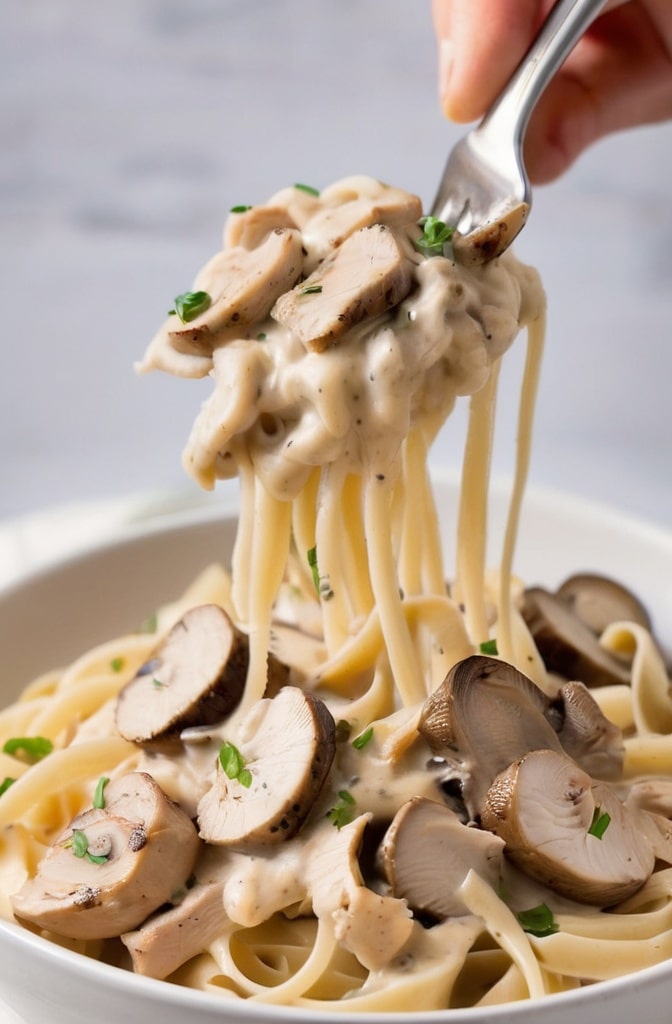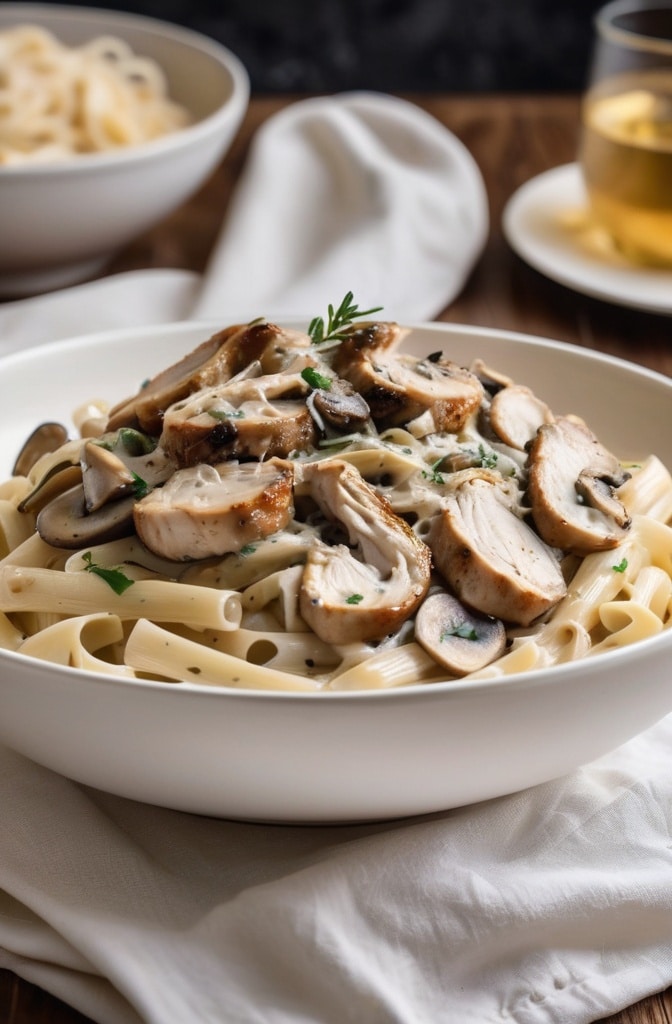I still remember the first time I made Chicken Mushroom Fettuccine Alfredo from scratch. The kitchen windows fogged up with steam, my forearms ached from whisking that silky sauce to perfection, and the intoxicating aroma of garlic-infused cream nearly made me forget the pasta boiling on the stove. What a glorious mess it was! Yet that first bite tender chicken, earthy mushrooms, and pasta coated in velvety alfredo sauce justified every moment of chaos.
Chicken Mushroom Fettuccine Alfredo sits proudly at the intersection of Italian-American comfort food and restaurant-worthy elegance. Its what I call the perfect “impresser dish” seemingly fancy yet surprisingly accesible to cooks of all levels. The combination of tender chicken, earthy mushrooms, and silky alfredo sauce creates a symphony of flavors that dance across your palate with each twirl of pasta.
Ingredients & Substitutions
Let’s talk about what makes this dish sing. Quality ingredients make all the diffrence here.
For the pasta:
- 1 pound fettuccine pasta (fresh is best, but dried works well too)
- Salt for pasta water (be generous like “tastes like the sea” generous)
For the chicken:
- 2 boneless, skinless chicken breasts (about 1 pound)
- 2 tablespoons olive oil
- 2 teaspoons Italian seasoning
- Salt and freshly ground black pepper
- 1 tablespoon unsalted butter
For the mushrooms:
- 8 ounces mushrooms (cremini or button), sliced
- 2 tablespoons unsalted butter
- 3 cloves garlic, minced
- 1 teaspoon fresh thyme leaves
- Salt and freshly ground black pepper
- 2 tablespoons dry white wine (optional)
For the alfredo sauce:
- 3 tablespoons unsalted butter
- 3 cloves garlic, minced
- 2 cups heavy cream
- 2 cups freshly grated Parmigiano-Reggiano cheese
- 1/4 teaspoon freshly grated nutmeg
- Salt and white pepper to taste
For garnish:
- Fresh parsley, chopped
- Extra Parmigiano-Reggiano, shaved
- Freshly cracked black pepper
Choosing the right mushrooms can elevate this dish immensely. Cremini (baby portobello) mushrooms provide a more robust flavor than white button mushrooms, but a mix of wild mushrooms—shiitake, oyster, or chanterelle creates an extraordinary depth of flavor. For those with dairy restrictions, cashew cream can substitute for heavy cream, and nutritional yeast can replace some of the cheesy flavor, though the texture will differ slightly.
Fresh pasta absorbs sauce differently than dried, creating a more luxurious mouthfeel. But high-quality dried fettuccine is perfectly acceptable. Just cook it about 30 seconds shy of the package directions for proper al dente texture.
Step-by-Step Instructions

Preparing the Chicken
First things first, let’s prep our protein. Pat those chicken breasts dry with paper towels—this is crucial for proper browning. Season generously with salt, pepper, and Italian seasoning on both sides.
Heat olive oil in a large skillet over medium-high heat until it shimmers but doesn’t smoke. Add your chicken and cook undisturbed for about 6-7 minutes per side, depending on thickness. A golden-brown crust should form. This is where impatience kills good chicken don’t fiddle with it! Let that beautiful Maillard reaction work its magic.
The most common mistake I see is overcooking the chicken. Use a meat thermometer and pull it off at 160°F (71°C) it’ll reach the safe 165°F while resting. Transfer to a cutting board and let it rest at least 5 minutes before slicing. This step is non-negotiable unless you enjoy dry, stringy chicken!
Mushroom Magic
In the same skillet (don’t you dare wash away those flavorful chicken bits!), melt butter over medium heat. Add sliced mushrooms and resist the urge to stir immediately. Let them sit undisturbed for 2-3 minutes until they begin to brown.
Once the mushrooms start to release moisture, add minced garlic and thyme. Season with salt and pepper, then cook for another 2-3 minutes. If using wine, add it now and let it reduce until almost completely evaporated, about 1-2 minutes. The alcohol cooks off, leaving behind complex acidity that balances the richness of the sauce.
Transfer the mushrooms to a plate, but don’t clean that skillet yet! We’re building layers of flavor here, people.
Crafting the Perfect Alfredo Sauce
Now for the star of our show the alfredo sauce. Wipe any burnt bits from your skillet (but keep the good stuff), and melt butter over medium-low heat. Add garlic and cook just until fragrant, about 30 seconds. Don’t let it brown or it’ll turn bitter.
Gradually pour in the heavy cream while whisking. Bring to a gentle simmer (never a boil that’s how you break a sauce) and cook for about 3-4 minutes until it starts to thicken slightly. Lower the heat and gradually add the grated Parmigiano-Reggiano, whisking constantly until melted and smooth.
Here’s where patience pays dividends. A rushed alfredo is a broken alfredo. Add the nutmeg and season with salt and white pepper to taste. The sauce should coat the back of a spoon but still flow smoothly. If it’s too thick, add a splash of pasta water. Too thin? Let it simmer a bit longer.
Cooking the Pasta
Meanwhile, bring a large pot of generously salted water to a rolling boil. Add the fettuccine and cook until al dente according to package instructions, usually 8-10 minutes for dried pasta or 2-3 minutes for fresh.
Before draining, reserve at least 1 cup of pasta cooking water this starchy liquid is liquid gold for adjusting sauce consistency later. Drain the pasta but never rinse it! That starch helps the sauce adhere to every strand.
Bringing It All Together
Return the pasta to its pot or a large serving bowl. Pour about two-thirds of the alfredo sauce over the hot pasta and toss gently to coat. Add the sliced chicken and sautéed mushrooms, then drizzle the remaining sauce over top. If the sauce seems too thick, add a splash of reserved pasta water and toss again.
For a variation that’ll knock your socks off, try adding roasted garlic instead of fresh, or fold in some blanched asparagus tips or peas for a pop of color and freshness. For heat seekers, a pinch of red pepper flakes adds pleasant warmth without overwhelming.
Cooking Techniques & Science

The magic of an exceptional alfredo sauce lies in understanding emulsification—the process of suspending fat molecules in liquid. When you gradually incorporate parmesan into warm (not hot) cream while constantly whisking, you’re creating a stable emulsion. If your sauce “breaks” and becomes grainy, it’s usually becuz the heat was too high or the cheese was added too quickly.
Properly sautéing mushrooms requires patience and high heat. Mushrooms contain about 90% water, which must evaporate before they can brown. That’s why we don’t crowd the pan and resist stirring initially crowding creates steam instead of caramelization. The Maillard reaction that occurs during browning creates hundreds of flavor compounds, transforming bland mushrooms into umami bombs.
For the chicken, I recommend using a cast-iron skillet if you have one. Cast iron retains heat exceptionally well, creating that perfect sear that seals in juices. And contrary to popular belief, searing doesn’t “lock in” moisture it creates flavor through (again) the Maillard reaction. The key to juicy chicken is proper cooking temperature and resting time.
Serving & Pairing Suggestions
Presentation matters almost as much as taste. Serve your Chicken Mushroom Fettuccine Alfredo in warmed shallow bowls, twirling the pasta into a neat mound. Arrange the chicken and mushrooms artfully on top, then drizzle with a touch more sauce. Garnish with shaved Parmigiano-Reggiano, freshly cracked black pepper, and a sprinkle of chopped parsley for color contrast.
A side of simply dressed arugula or garlic bread makes the perfect accompaniment. The peppery bite of arugula cuts through the richness, while garlic bread provides textural contrast and sauce-sopping capabilities.
For wine pairing, I’m partial to a crisp, unoaked Chardonnay or a light-bodied Pinot Noir. The acidity helps balance the creamy sauce, while the fruit notes complement the savory elements. Alternatively, a dry Prosecco offers palate-cleansing bubbles between those rich, creamy bites.
For a complete dinner party menu, start with a light antipasti platter, follow with this showstopping pasta, and finish with a simple lemon sorbet to cleanse the palate.
Final Thoughts
Chicken Mushroom Fettuccine Alfredo isn’t just a meal it’s an experience meant to be savored slowly. The beauty of this dish lies in its balance: rich yet not overwhelming, complex yet comforting, impressive yet achievable.
The key to mastery lies in understanding the “why” behind each step. Why we sear the chicken before slicing, why we cook the mushrooms in the same pan, why we never allow the sauce to boil. These aren’t arbitrary rules but fundamental techniques that elevate good food to great food.
Whether you’re cooking for a special occasion or simply treating yourself after a long week, this dish delivers that restaurant-quality experience without requiring culinary school credentials. It’s adaptable, forgiving, and never fails to impress. Just remember to save a little room for seconds you’ll definitely want them.
FAQs
Why did my alfredo sauce break and become grainy?
The most common culprit is too much heat. Alfredo sauce should never boil—keep it at a gentle simmer. Another potential issue is adding cold cheese to hot cream too quickly. Gradually incorporate room-temperature cheese while whisking constantly. If disaster strikes, you can sometimes rescue a broken sauce by removing from heat and whisking in a tablespoon of cold heavy cream.
Can I make this dish ahead of time?
Alfredo sauce doesn’t reheat well as it tends to separate. If you need to prepare components ahead, cook the chicken and mushrooms and refrigerate separately. Make the sauce and cook the pasta just before serving. For leftovers, reheat gently with a splash of cream to help reconstitute the sauce.
What’s the best way to reheat leftover fettuccine alfredo?
Low and slow is the way to go. Place in a skillet over low heat with a splash of cream or milk, and heat gently while stirring occasionally. Microwaving is convenient but often yields less desirable results if you must, use 50% power and stir frequently.
How can I make this dish lighter without sacrificing flavor?
While traditional alfredo is unapologetically indulgent, you can create a lighter version by substituting half-and-half for heavy cream and using slightly less butter. Adding a ladleful of starchy pasta water helps create creaminess with less fat. You could also increase the ratio of mushrooms to pasta for a more veggie-forward dish.
Why do some recipes include flour or cream cheese in alfredo sauce?
Traditional alfredo sauce contains only butter, cheese, and pasta water—no cream or thickeners. American adaptations often include heavy cream for richness and stability. Some recipes add flour or cream cheese as insurance against breaking, but a properly executed traditional technique doesn’t require these additions.

